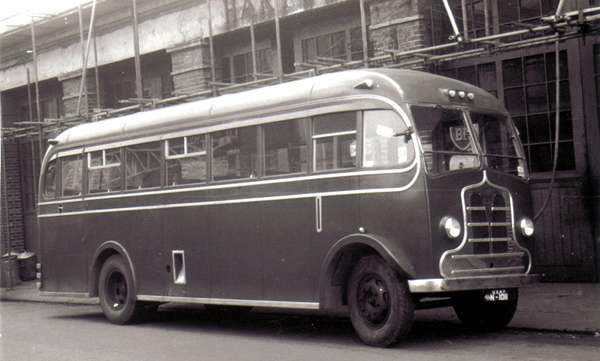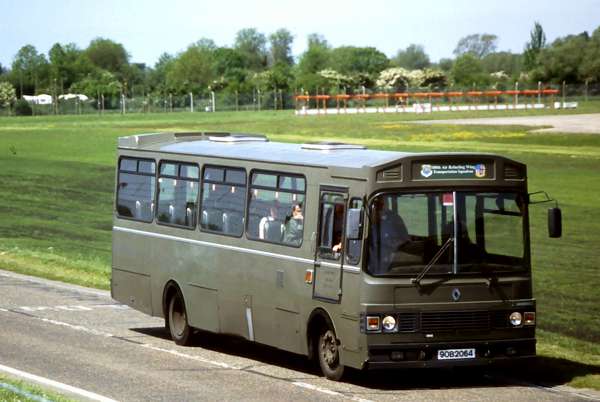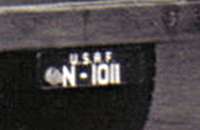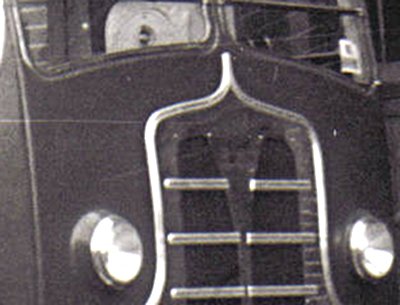USAF N 1011
USAF N 1011

I have never seen one like this before. It is serving with US Air Force in UK. My first thought was that maybe they brought it with them, however, I would suggest that, other than the front, the bodywork is undeniably British. Does the front end have a Mann Egerton feel about it? Can anyone help to ID this one?
Les Dickinson
27/05/13 - 16:41
This has many features similar to the Sentinals and other integrals produced by Beadle?
Andrew Charles
27/05/13 - 16:41
Well, this is interesting! Visually the radiator cover is almost identical to that used on the batch of Crossley SD42/Whitson observation coaches supplied to the USAF in the early 1950s, but the straight rail bodywork is highly reminiscent of the design used for Plaxton bus bodies between circa 1950 and the introduction of the Highway in 1957. There weren't many of this type of body (by 1950 Plaxton's service bus output had become almost negligible), but one well-known example was a Commer Avenger, ONT 960, which ran for Martlew in the Wellington(Shropshire)area and later passed to Carney of Rugeley. Of course, this is only conjecture, and may be no help whatsoever! I look forward to reading a definitive answer from somebody else.
Neville Mercer
27/05/13 - 16:42
This looks like a posed manufacturer's shot, albeit in front of a scaffolded building. That sign wouldn't say Harrington's would it?
The vehicle is a narrow chassis and, whilst the body may be 8 feet wide, it doesn't look it.
I've tried to magnify the motif on the grille and it may well be the Guy Motors logo, the one with a large stylised G surrounding the wording Guy Motors Ltd. The front wheel pressing is identical to those used by Guy on Vixen chassis, both truck and coach.
USAF vehicles used in the UK used to have US standard lights as the rules of the road on the bases were US rules, though for running on UK roads there is a slot for a trafficator which dates the photo before 1955.
Unfortunately I haven't found any written or photo evidence to back up my interpretation of the visual clues. Is there any more info regarding the photo, or where it was sourced?
Phil Blinkhorn
27/05/13 - 16:43
Les,
The radiator grille has a 'whiff' of Austin about it and Mann Egerton certainly bodied many of the comparatively few Austin coaches that were built, so you could be on the right track, though that is only a guess on my part.
Eric Bawden
27/05/13 - 16:43
Could it be a lightweight Guy in the Otter-Wolf-Vixen range? The tapering plate down the centre of the radiator suggests that, although it was usually applied to underfloors. As to body, no idea!
Ian Thompson
28/05/13 - 07:49
Phil, Sorry I have no information on this. Photo, like many of my postings was bought from RHG Simpson. I also wondered if the overhead sign was for Harringtons, however this bus appears to be standing in front of commercial fuel pumps, though not refuelling - the fuel filler looks to be offside. The steering wheel is not visible to see if lhd/rhd
Les Dickinson
28/05/13 - 08:44

I can't identify make and model of chassis or body, but I can tell you that, until very recently, USAF were buying vehicles intended for UK service over here: Leyland Sherpa vans and Renault buses, for example. It helped when they were selling them on. Their registrations have, typically, been arranged as year of purchase, B for Britain, and a number. I attach a view of such a vehicle, though it is well outside the normal scope of this site. 90B2064 was seen on duty at RAF Mildenhall in May 2001. I can't help but wonder - my magnifying glass isn't powerful enough! - if the N is not actually the first digit.
Pete Davies
28/05/13 - 11:04
Pete, looking at the photo with Photoshop, the first letter is still indistinct but is most likely B. I'm not sure when UK built US Forces vehicles for use here on public roads had to conform solely to UK lighting regulations, as is evident on your photo, but I seem to think it was around 1968
Les, The fuel pump may be a red herring. Having visited many premises with private fuel pumps displaying an oil company's logo or signage, the use of such on pumps is not indicative of a retail operation.
What we really need is someone who knew, or has photo evidence of, Harrington's premises to come forward so we can eliminate Harrington's from our enquiries.
Phil Blinkhorn
28/05/13 - 11:09

A little blow up for you.
Peter
28/05/13 - 11:52
Now that's cheating Peter - having access to a better version of the photo. The best I could do with Photoshop was to decide it was a B, D or O and, knowing B was used for UK vehicles, fell into the trap! That looks like a badge or seal similar to the ones used on German licence plates.
Can you provide a similar blow up of what looks like a badge at the top of the radiator grille?
Phil Blinkhorn
28/05/13 - 11:55

No problem
Peter
28/05/13 - 16:50
That's much clearer than I could get and there looks to be no badge there though the curved mark under the top centre of the chrome beading which I took to be the Guy G is now clarified as just a mark on the print.
I still think the wheels point to a Guy however.
Phil Blinkhorn
28/05/13 - 16:51
The scroll at the top of the radiator does have some resemblance to "Foden", but the narrow track of the front axle suggests a lighter type of vehicle than the usual Sandbach offerings.
Roger Cox
28/05/13 - 16:52
Phil B mentions the need for someone familiar with the old Harrington building in Hove. I've been having a look at a website dealing with Harrington products (www.thcoachwork.co.uk) and the illustration on that site's front page doesn't match the building pictured behind the bus. Could the sign say "HAN . . ."? which leads me to wonder about Hants & Dorset or Hants & Sussex. I don't think so, somehow!
Pete Davies
28/05/13 - 16:56

Another little blow up
Peter
29/05/13 - 06:52
Peter's blow up shows the fourth letter is neither an R or an N, and Pete's message re the Harrington book confirms it, so back to the drawing board
Whilst there is a resemblance to the Foden emblem on the grille I'd have thought there was enough Foden knowledge here, in books and on the Net for this vehicle to have been well known were it a Foden.
Phil Blinkhorn
01/06/13 - 06:27
As I implied in my note, Phil, I don't think this is a Foden either. However, what about it being an Austin? The axles do have a similarity to those of Austin lorries of this period, and these also had offside fuel tanks.
Roger Cox
01/06/13 - 15:36
Roger, as I suggested in my posting of 27th May 16:43!
Eric Bawden
02/03/16 - 11:06
I have a theory on the location of this picture. King & Harper were a commercial garage in Cambridge, so could these premises be theirs? With scaffold up and signs of renovation the 'KING &' lettering could have been removed. They would also have had fuel pumps. They were AEC agents at the time and also Morris Commercial dealers (I think).
With American airbases at Mildenhall, Lakenheath, Alconbury and Molesworth etc. close by it could be a possibility?
Jim Neale
02/03/16 - 14:39
Jim Neale, I like the suggestion on this. Do you recall the address or actual location of the company? I lived in St Ives for six years and have a little knowledge of Cambridge. My wife worked in Sidney Street at that time.
Les Dickinson
03/03/16 - 05:04
We seem now to be on the right track. Whilst this film dates from the early 1930s, the Milton Rd premises look likely. No further forward with the bus though!
Phil Blinkhorn
03/03/16 - 05:04
Not exactly the right period but some film of King & Harper 1947 a delightful film of some aspects of transport and life in Cambridge at that time. See this link.
John Lomas
03/03/16 - 15:01
Can we identify a time frame? Could this have been soon after the war? Semaphore indicators could be a clue? King & Harper had commercial garages on Milton Rd and Hills Rd. I knew 2 men who served AEC apprenticeships at K&H but sadly they are no longer around to ask.
My Mum worked in the stores office for a couple of years during the war but that was in Bridge St., which was not just a garage as seen in the film but cycle shop, also selling domestic appliances etc..
Most of the USAF vehicles used on bases were brought over from the states so this bus is probably American, maybe their version of Austerity?
Jim Neale
03/03/16 - 15:52
If this were an import surely it would be LHD. The picture shows a sliding window where the driver of an RHD would be and there is no entrance on the RH side.
John Lomas
04/03/16 - 16:57
My guess is that the chassis is Austin CXB, the wheels look the same as in this pic.
So that would point to the body being Mann Egerton!
John Wakefield
04/03/16 - 17:55
The bus in the photo is one of 55 supplied to the USAF in 1951, which were followed by a further 25 the following year. It is an Austin K4/CXD with Whitson bodywork. The same photo appears in John Carman's book 'Austin K Series Buses and Coaches' along with the above information.
John Stringer
05/03/16 - 05:19
John, you beat me to it by a short head. I had got as far as this: https://myntransportblog.files.
which is from 1950. Note the grille which incorporates the Foden emblem which looks to have been copied, minus the name, onto the Austin.
But why would Whitson win such orders? Well the USAF UK HQ was at South Ruislip, close to Whitson's works so a close overview could be kept during building. As far as King and Harper are concerned, given the preponderance of USAF bases in East Anglia, a Cambridge based garage to service the vehicles would make sense.
Whilst the bases were more than capable of maintaining vehicles, it is unlikely that each base would carry spares for a relatively small number of non standard vehicles, also the mechanics would have to be trained on all but the most routine of jobs so a central base would work well for both routine servicing and emergency repairs and K&H were also expert body repairers.
Phil Blinkhorn
05/03/16 - 09:24
If the building is King & Harper it would have been Bridge Street, Cambridge. Its a one way street now with traffic flowing the opposite way to the direction the bus is parked. The old garage was demolished & re developed into shops long ago.
John Wakefield
07/03/16 - 13:35
It seems likely that Whitson got the order to body these because of the previous order for Crossley SD42/9s with observation coach bodywork by that company. This allegedly came about after a USAF officer in charge of vehicle procurement saw the Foden PVSC6/Whitson observation coach exhibited (in Salopia livery) in New York City. The USAF in the UK had a requirement for a batch of vehicles suited to the transportation of military bands, sports teams etc and the Whitson alternative was suggested because of the large luggage area beneath the raised section of seating. The USAF, having approved the bodywork style shown in New York, insisted on the pseudo-Foden grille on the front of the Crossleys. Presumably the Austins got them for the sake of uniformity.
Going off at a slight tangent, does anyone know the disposal details for either the Crossleys or the Austins? Apart from one of the observation coaches in service with a North Wales operator (which received a 1959 registration despite its age) I've never come across any others with UK operators.
Neville Mercer
Comments regarding the above are more than welcome please get in touch via the 'Contact Page' or by email at obp-admin@nwframpton.com
All rights to the design and layout of this website are reserved
Old Bus Photos from Saturday 25th April 2009 to Wednesday 3rd January 2024